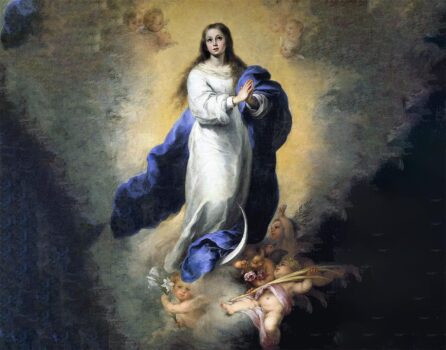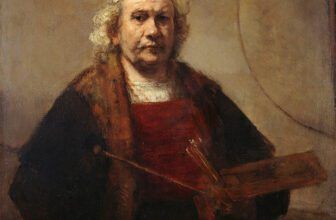Bartolome Esteban Murillo’s Most Famous Paintings
In the annals of Spanish Baroque painting, a few names resonate with enduring brilliance, among them, none is more cherished for warmth, humanity, and divine serenity than Bartolome Esteban Murillo. Born in Seville during a period of profound cultural and religious transformation, Murillo’s work captures the essence of 17th-century Spain: devout, dramatic, and deeply human.
Murillo’s paintings continue to draw admiration across the world, not only for their technical brilliance but for their spiritual tenderness and emotional accessibility. From the innocent glow of street children to the luminous grace of the Virgin Mary, his art is a window into both celestial and earthly realms.
In this post, we explore Murillo’s fascinating life, his most famous paintings, where his artworks reside today, and why his legacy endures through centuries.
A Devout Brushstroke in Seville’s Golden Age
Bartolome Esteban Murillo was born at the end of 1617 (most likely December) and baptized on January 1, 1618, in Seville, Spain. He was the youngest of fourteen children born to a well-off barber-surgeon and his wife. Orphaned by the age of ten, Murillo was taken in by relatives, one of whom likely supported his artistic education.
Murillo’s early training is attributed to Juan del Castillo, a relative and competent painter. Though initially influenced by the Mannerism of his teacher, Murillo’s style matured into something uniquely emotive and graceful. A crucial turning point came after a visit to Madrid in the 1640s, where he studied works by Velázquez, Rubens, and Titian, absorbing their techniques and refining his own.
Returning to Seville, he began producing religious paintings for churches and monasteries. It was here that Murillo carved out a reputation as the leading painter of Seville’s religious elite, while also capturing the soul of the common people. His mastery of soft light, tender expression, and realistic detail earned him acclaim not just in Spain, but eventually across Europe.
Murillo died tragically in 1682 after falling from scaffolding while working on a fresco in Cádiz. Despite his untimely death, his artistic flame never dimmed.
What Is Bartolome Esteban Murillo Known For?
Murillo is best known for:
Religious works, particularly of the Virgin Mary, Christ, and various saints, rendered with emotion and grace.
Genre paintings of Seville street children, which brought rare dignity to the lives of the poor.
A soft, luminous style that became a hallmark of Spanish Baroque painting.
His role as the founder of Seville’s Academy of Art in 1660, shaping generations of Spanish artists.
His works combined Italian Renaissance harmony, Flemish realism, and a deeply Spanish spirituality, resulting in a style that was tender, emotionally resonant, and unmistakably his own.
Bartolome Esteban Murillo’s Most Famous Paintings
1. The Immaculate Conception of Los Venerables (c. 1678)
Location: Museo del Prado, Madrid
Arguably Murillo’s most iconic painting, this work epitomizes his mature style. The Virgin Mary is shown ascending amid heavenly clouds and cherubs, radiating divine purity. The softness of her face, the subtle use of light, and the ethereal atmosphere made this an emblematic depiction of Catholic devotion. It’s also the most famous “Immaculate Conception” from among many he painted.
2. The Young Beggar (c. 1650)
Location: Louvre Museum, Paris
One of the most celebrated genre paintings in art history, this shows a young boy picking lice from his shirt, tattered and barefoot, yet rendered with dignity. The background is dark, focusing attention on the boy’s expression. It’s a masterful blend of realism and empathy, elevating the everyday to the sublime.
3. Two Women at a Window (c. 1665–1675)
Location: National Gallery of Art, Washington D.C.
In a rare moment of playful charm, Murillo captures two young women peeking out of a window. One giggles behind a veil, while the other looks directly at the viewer. This delightful scene blends portraiture with genre painting and shows Murillo’s lighter, more secular side.
4. The Holy Family with a Little Bird (c. 1650)
Location: Prado Museum, Madrid
Here, the young Jesus plays with a bird while Mary and Joseph look on tenderly. Murillo’s rendering of light and the emotional warmth between the figures make it a touching, intimate portrayal of divine family life.
5. Saint John the Baptist as a Boy (c. 1655)
Location: Louvre Museum, Paris
This depiction of a youthful St. John showcases Murillo’s talent for imbuing religious themes with innocence and humanity. The boy’s soft features, wild curls, and calm demeanor make it both spiritually potent and emotionally engaging.
What Is the Most Expensive Painting by Bartolome Esteban Murillo?
While exact figures can fluctuate due to private sales and undisclosed auctions, “The Immaculate Conception of Los Venerables” is considered Murillo’s most valuable work.
In fact, this masterpiece was looted by Napoleon’s army and taken to France in the 19th century. It was returned to Spain only after long diplomatic negotiations, highlighting not just its monetary value but also its cultural and spiritual significance.
As for sales on the open market, Murillo’s paintings have fetched millions of dollars at auction, particularly his genre scenes and religious compositions. A notable sale occurred at Christie’s in 2013, when “The Infant Saint John the Baptist with the Lamb” sold for over $3 million USD.
How Many Paintings Did Bartolome Esteban Murillo Create?
Murillo’s total known output is estimated to be around 400 paintings, though the exact number varies due to:
Lost or destroyed works
Attributions and misattributions
Sketches, drawings, and unfinished works
Among these, roughly 100–150 are major religious works, including numerous altarpieces and commissions for churches and monasteries. He also produced many genre paintings, now considered groundbreaking for their time.
The Legacy of Bartolome Esteban Murillo
Murillo’s legacy is multifaceted:
1. Religious Iconography
Murillo’s imagery of the Immaculate Conception became the standard visual representation in Catholic art for generations. His idealized Madonnas and cherubic angels became models for future religious painters.
2. Humanizing the Poor
At a time when the poor were often dismissed or demonized, Murillo painted them with tenderness and dignity. His images of beggar children and humble workers bring their humanity into sharp relief.
3. Art Education in Seville
In 1660, Murillo co-founded the Academia de Bellas Artes in Seville, playing a crucial role in nurturing a generation of artists and formalizing art instruction in Andalusia.
4. Influence on European Art
Murillo’s works were collected avidly in England and France during the 18th and 19th centuries. Artists such as Joshua Reynolds and Thomas Gainsborough admired his compositions and emotional resonance.
Where Are Bartolome Esteban Murillo’s Paintings Located Today?
Murillo’s paintings are spread across major museums and institutions worldwide. Notable collections include:
Spain
Museo del Prado, Madrid – houses some of Murillo’s finest religious works.
Seville Cathedral – home to several large altarpieces and religious murals.
Museo de Bellas Artes, Seville – features early works and local commissions.
France
Louvre Museum, Paris – holds genre scenes and religious portraits.
United Kingdom
National Gallery, London – features several Murillo masterpieces.
United States
National Gallery of Art, Washington, D.C. – houses “Two Women at a Window.”
Metropolitan Museum of Art, New York – features religious works and portraits.
Germany, Russia, and Latin America
Works by Murillo are also found in the Hermitage Museum (St. Petersburg), Gemäldegalerie (Berlin), and Museo de Arte de Ponce (Puerto Rico).
Many of Murillo’s works also reside in private collections or churches throughout Spain and Latin America.
The Eternal Softness of Murillo’s Vision
Bartolome Esteban Murillo was not just a master of composition and color, he was a painter of souls. His brush captured not only divine light but the beating heart of Seville’s people, its churches, and its alleyways. In a time of religious tension and poverty, he offered images of hope, warmth, and serenity.
More than three centuries later, his work continues to inspire artists, comfort believers, and move all who stand before it. His legacy endures in soft glows, cherubic smiles, and the quiet dignity of those whom society once overlooked.
To encounter Murillo’s paintings is to experience the quiet miracle of art that listens, feels, and remembers.




